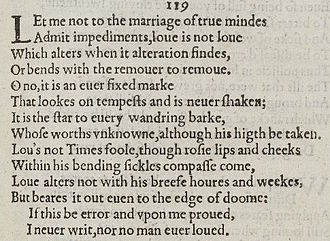Table of Contents
ToggleIntroduction to Sonnet 116
Poem Sonnet 116 By William Shakespeare Summary William Shakespeare’s Sonnet 116 is one of the most celebrated pieces in the collection of 154 sonnets he wrote, often referred to as the “Shakespearean sonnets.” This sonnet stands out for its profound exploration of love, particularly the nature and constancy of true love. Written in a time when romantic relationships were often influenced by societal norms and expectations, Sonnet 116 defines love in its most ideal and unwavering form. It serves not only as a declaration of what love is but also as a refutation of any concept of love that is conditional or temporary.
Summary of Sonnet 116
Quatrain 1: Defining True Love
Poem Sonnet 116 By William Shakespeare Summary The sonnet begins with a powerful assertion: “Let me not to the marriage of true minds / Admit impediments.” Here, the speaker is rejecting any obstacles that might interfere with the union of two true lovers. The phrase “true minds” emphasizes the idea that true love exists between individuals who understand and accept each other deeply. This opening sets a tone of certainty and conviction.
The next lines state that “Love is not love / Which alters when it alteration finds.” The speaker asserts that genuine love does not change when circumstances shift or when challenges arise. This is a key element of Shakespeare’s definition of love—its steadfastness regardless of external factors. Furthermore, the speaker insists that love does not “bend with the remover to remove,” meaning it does not waver in the face of adversity or when one partner chooses to withdraw. This emphasizes the unwavering nature of true love.
Quatrain 2: The Stability of Love
In the second quatrain, the speaker elaborates on the qualities of true love by comparing it to an “ever-fixed mark” that remains constant despite turbulent circumstances. The metaphor of “tempests” suggests that love is not easily shaken by difficulties or storms. It represents stability and reliability in times of hardship.Poem Sonnet 116 By William Shakespeare Summary
Shakespeare then introduces the image of a “star to every wandering bark.” In this context, a “bark” refers to a ship, and the star serves as a guiding light for lost vessels. This metaphor illustrates how true love provides direction and purpose, guiding individuals through life’s uncertainties. The line “Whose worth’s unknown, although his height be taken” suggests that the true value of love cannot be quantified or measured, emphasizing its intrinsic worth.Poem Sonnet 116 By William Shakespeare Summary

Quatrain 3: The Timelessness of Love
The third quatrain introduces the concept of time, stating that “Love’s not Time’s fool.” The speaker acknowledges that physical beauty, represented by “rosy lips and cheeks,” is subject to the ravages of time, as indicated by “within his bending sickle’s compass come.” This image of the “bending sickle” alludes to the Grim Reaper and symbolizes death. While beauty fades and time may diminish physical attributes, true love endures beyond these superficial changes.
Poem Sonnet 116 By William Shakespeare Summary The speaker reinforces this idea with the assertion that “Love alters not with his brief hours and weeks.” True love does not waver or diminish with the passage of time; instead, it “bears it out even to the edge of doom.” This powerful line indicates that genuine love remains steadfast until the end of life, making it timeless and eternal.
READ MORE
Couplet: The Certainty of Love
The concluding couplet serves as a definitive statement on the speaker’s views about love. He declares, “If this be error and upon me proved, / I never writ, nor no man ever loved.” This strong assertion implies that if the speaker’s definition of love is incorrect, then he has never written anything of value, nor has any man truly experienced love. This final declaration solidifies the speaker’s confidence in his understanding of true love, creating a compelling closure to the sonnet.Poem Sonnet 116 By William Shakespeare Summary
Themes in Sonnet 116
1. The Nature of True Love
The central theme of Sonnet 116 is the definition of true love. Shakespeare portrays love as an unwavering, constant force that remains unchanged despite external circumstances or the passage of time. This theme invites readers to contemplate the nature of their own relationships and the qualities that define true love.
2. Love vs. Time
Poem Sonnet 116 By William Shakespeare Summary Shakespeare contrasts the permanence of love with the transient nature of physical beauty and time. The poem explores how love transcends time and does not succumb to the effects of aging or mortality. This theme suggests that while physical attributes may fade, the essence of true love remains intact.
3. Endurance and Stability
The imagery of stability, such as the “ever-fixed mark” and the guiding “star,” underscores the theme of endurance in love. Shakespeare conveys the idea that true love serves as a source of strength and guidance, providing support during difficult times. This theme emphasizes the importance of resilience in romantic relationships.Poem Sonnet 116 By William Shakespeare Summary
4. Love and Selflessness
The poem highlights the selfless nature of true love. The speaker’s commitment to defining love based on its constancy and unwavering support reflects a deep understanding of love as a partnership built on mutual respect and care. This theme encourages readers to consider the importance of selflessness in their own relationships.
5. Certainty and Conviction
Shakespeare’s confident tone throughout the sonnet conveys a sense of certainty about love. The speaker’s unwavering belief in his definition of love emphasizes the importance of conviction in understanding and experiencing love. This theme reinforces the idea that love is not merely an emotion but a profound commitment.
Analysis of Language and Form
Sonnet Structure
Sonnet 116 is written in the traditional Shakespearean sonnet form, consisting of 14 lines divided into three quatrains followed by a rhymed couplet. The rhyme scheme (ABABCDCDEFEFGG) creates a sense of progression and flow, allowing the speaker to build his argument regarding the nature of love.
Imagery and Metaphor
Shakespeare employs rich imagery and metaphor throughout the sonnet to convey complex ideas about love:
- Natural Imagery: The references to the “ever-fixed mark” and the “star” evoke feelings of stability and guidance, symbolizing the strength of true love. This imagery reflects the idea that love can provide direction in times of uncertainty.
- Temporal Imagery: The “bending sickle” signifies the passage of time and mortality, juxtaposing the fleeting nature of physical beauty with the permanence of true love. This imagery emphasizes the idea that love transcends the limitations imposed by time.
- Marital Imagery: The opening line’s reference to the “marriage of true minds” encapsulates the essence of love as a union of understanding and acceptance, reinforcing the idea of partnership.
Sound and Rhythm
The poem is composed in iambic pentameter, which gives it a rhythmic quality that enhances its musicality. The use of enjambment in several lines creates a sense of continuity and flow, allowing the speaker’s thoughts to unfold seamlessly. This rhythm contributes to the overall impact of the poem, drawing readers into the speaker’s emotional journey.
Interpretations and Critiques
Sonnet 116 has been the subject of extensive literary analysis and critique, with scholars exploring its themes and implications in various contexts. Some interpretations emphasize the poem’s idealism, suggesting that Shakespeare presents a vision of love that is aspirational and perhaps unattainable in real life. Critics have noted that while the poem articulates a powerful understanding of love, it may not fully capture the complexities and imperfections inherent in human relationships.
Additionally, some readings explore the sonnet’s relevance in contemporary discussions about love, examining how the themes of enduring love and emotional stability resonate with modern audiences. The poem’s focus on selflessness and commitment continues to be applicable in today’s romantic relationships, prompting readers to reflect on their own definitions of love.

Conclusion
In conclusion, Shakespeare’s Sonnet 116 stands as a profound exploration of the nature of true love. Through its rich imagery, powerful metaphors, and unwavering conviction, the sonnet articulates a vision of love that is constant, enduring, and transcendent. The poem invites readers to reflect on their own experiences of love and the qualities that define their relationships.
By defining love in its most ideal form, Sonnet 116 serves as a reminder of the potential for love to elevate and transform the human experience. Shakespeare’s exploration of love’s permanence in the face of time and adversity resonates across generations, making it a timeless and universal piece of literature.
(FAQ)
Q1: What is the main theme of Sonnet 116?
The main theme of Sonnet 116 is the definition of true love as an unwavering, constant force that does not change with circumstances or the passage of time.
Q2: How does the poem describe the nature of love?
The poem describes love as an “ever-fixed mark” that provides guidance and stability, remaining steadfast through life’s challenges and the effects of aging.
Q3: What role does time play in Sonnet 116?
Time is portrayed as a force that can diminish physical beauty, represented by the imagery of a “bending sickle,” but true love transcends time and remains unchanged.
Q4: What literary devices are used in Sonnet 116?
Shakespeare employs various literary devices, including metaphors, imagery, and enjambment, to convey complex ideas about love and its enduring nature.
Q5: What is the significance of the concluding couplet in Sonnet 116?
The concluding couplet emphasizes the speaker’s certainty in his definition of love. It asserts that if his understanding of love is incorrect, then he has never written anything of value, reinforcing the importance of his claims.
Q6: How does Sonnet 116 compare to other Shakespearean sonnets?
Sonnet 116 shares themes of love, constancy, and emotional depth with other Shakespearean sonnets, particularly those in the Fair Youth sequence, but it stands out for its idealistic portrayal of love.
Q7: Why is Sonnet 116 considered one of Shakespeare’s most famous sonnets?
Sonnet 116 is renowned for its eloquent exploration of love’s nature and its timeless themes, making it a popular choice for study, recitation, and reflection on the complexities of romantic relationships.
READ MORE

















